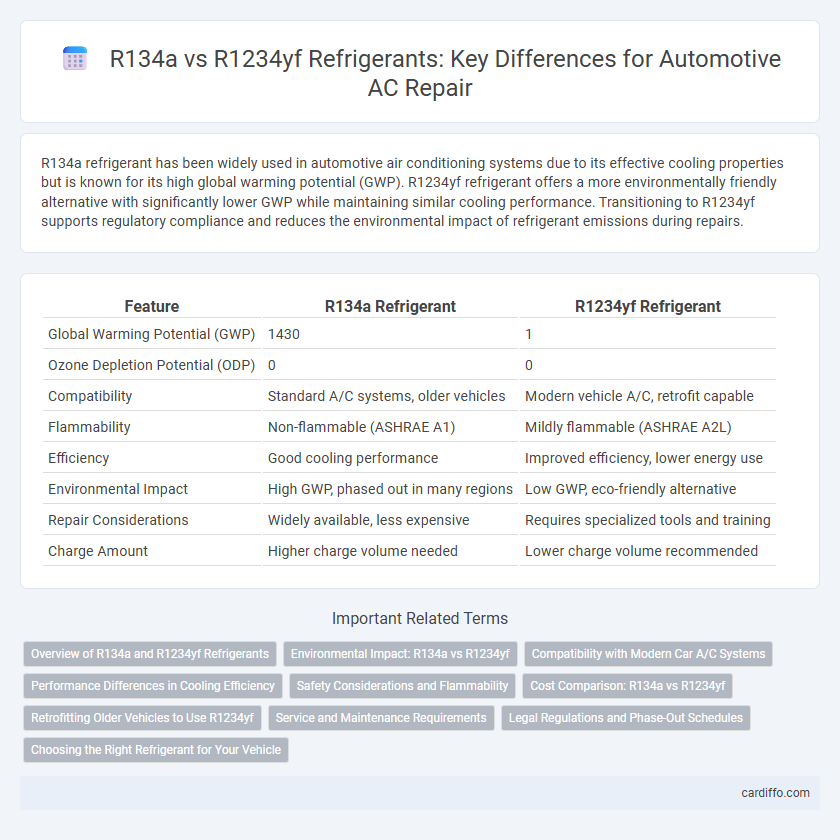R134a refrigerant has been widely used in automotive air conditioning systems due to its effective cooling properties but is known for its high global warming potential (GWP). R1234yf refrigerant offers a more environmentally friendly alternative with significantly lower GWP while maintaining similar cooling performance. Transitioning to R1234yf supports regulatory compliance and reduces the environmental impact of refrigerant emissions during repairs.
Table of Comparison
| Feature | R134a Refrigerant | R1234yf Refrigerant |
|---|---|---|
| Global Warming Potential (GWP) | 1430 | 1 |
| Ozone Depletion Potential (ODP) | 0 | 0 |
| Compatibility | Standard A/C systems, older vehicles | Modern vehicle A/C, retrofit capable |
| Flammability | Non-flammable (ASHRAE A1) | Mildly flammable (ASHRAE A2L) |
| Efficiency | Good cooling performance | Improved efficiency, lower energy use |
| Environmental Impact | High GWP, phased out in many regions | Low GWP, eco-friendly alternative |
| Repair Considerations | Widely available, less expensive | Requires specialized tools and training |
| Charge Amount | Higher charge volume needed | Lower charge volume recommended |
Overview of R134a and R1234yf Refrigerants
R134a refrigerant, widely used in automotive air conditioning systems, offers strong cooling performance but has a high global warming potential (GWP) of 1430, causing environmental concerns and regulatory restrictions. R1234yf refrigerant serves as a more eco-friendly alternative, featuring a low GWP of 4 and compliance with current environmental standards while maintaining similar thermodynamic properties for efficient cooling. Repair technicians must consider compatibility, safety procedures, and specialized equipment when transitioning from R134a to R1234yf in vehicle air conditioning systems.
Environmental Impact: R134a vs R1234yf
R134a refrigerant has a high Global Warming Potential (GWP) of 1430, significantly contributing to greenhouse gas emissions when leaked during vehicle air conditioning system repairs. In contrast, R1234yf boasts a substantially lower GWP of less than 1, making it a more environmentally friendly choice that complies with modern environmental regulations. Transitioning to R1234yf reduces the carbon footprint of automotive AC systems and aligns with global efforts to mitigate climate change.
Compatibility with Modern Car A/C Systems
R134a refrigerant is widely used but faces compatibility challenges with modern car A/C systems designed for higher efficiency and lower environmental impact. R1234yf refrigerant is specifically engineered to match the performance requirements of new vehicle A/C systems while offering lower global warming potential (GWP). Automotive manufacturers increasingly mandate R1234yf due to its compliance with evolving environmental regulations and optimized compatibility with advanced A/C system components.
Performance Differences in Cooling Efficiency
R1234yf refrigerant exhibits superior cooling efficiency compared to R134a, delivering approximately 10-15% improved energy performance in automotive air conditioning systems. This enhanced efficiency results from R1234yf's lower global warming potential (GWP) of 4, compared to R134a's GWP of 1430, enabling better thermodynamic properties and reduced compressor energy consumption. Repair technicians note that systems running on R1234yf maintain more consistent cooling output under varied operating conditions, contributing to better overall HVAC system reliability and reduced fuel consumption.
Safety Considerations and Flammability
R134a refrigerant is non-flammable and widely used in automotive air conditioning systems due to its safety profile, whereas R1234yf refrigerant is mildly flammable with a lower global warming potential, requiring careful handling during repair to prevent fire hazards. Technicians must follow specific safety protocols and use appropriate leak detection tools when working with R1234yf to mitigate risks associated with its flammability. Proper ventilation and the avoidance of ignition sources are critical safety considerations when repairing systems charged with R1234yf refrigerant.
Cost Comparison: R134a vs R1234yf
R134a refrigerant generally costs less per pound compared to R1234yf, making it a more economical option for vehicle AC repairs. However, R1234yf's higher initial price is offset by its superior energy efficiency and lower environmental impact due to a significantly lower global warming potential (GWP). Repair shops must weigh upfront refrigerant costs against long-term savings and regulatory compliance when choosing between R134a and R1234yf.
Retrofitting Older Vehicles to Use R1234yf
Retrofitting older vehicles from R134a to R1234yf refrigerant requires compatibility checks of the AC system components to handle the lower global warming potential and increased flammability of R1234yf. This process involves replacing seals, lubricants, and possibly the compressor to ensure optimal performance and avoid leaks. Proper retrofitting aligns with environmental regulations while maintaining system efficiency and safety in vintage vehicles.
Service and Maintenance Requirements
R134a refrigerant requires regular leak checks and periodic oil changes due to its higher global warming potential and chemical stability. R1234yf offers easier serviceability with less stringent handling procedures and improved environmental safety, reducing the frequency of maintenance and disposal concerns. Technicians must use specialized equipment for R1234yf because of its mildly flammable nature, ensuring compliance with safety standards during repairs.
Legal Regulations and Phase-Out Schedules
R134a refrigerant is subject to strict legal regulations due to its high global warming potential (GWP) and has been phased out in many regions under international agreements such as the Kigali Amendment to the Montreal Protocol. R1234yf refrigerant, with a significantly lower GWP, is mandated as the replacement in automotive air conditioning systems, complying with evolving environmental regulations in the EU, USA, and other jurisdictions. Phase-out schedules require garages and repair shops to handle R134a use and disposal with certified equipment and transition to R1234yf to meet compliance and avoid penalties.
Choosing the Right Refrigerant for Your Vehicle
Choosing the right refrigerant for your vehicle involves comparing R134a and R1234yf based on environmental impact, efficiency, and compatibility. R1234yf is favored for its low Global Warming Potential (GWP) of 1, making it a more eco-friendly option compared to R134a's GWP of 1430, and it meets current regulatory standards in many regions. Technicians must ensure proper handling and system compatibility, as R1234yf requires specific tools and safety protocols due to its mildly flammable nature.
R134a refrigerant vs R1234yf refrigerant Infographic

 cardiffo.com
cardiffo.com